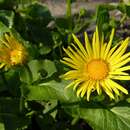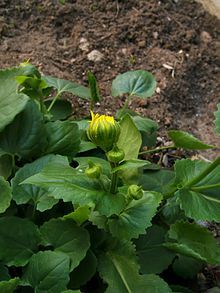pt-BR
nomes no trilho de navegação


Balkangemserod (Doronicum orientale) er en europæisk planteart i kurvblomst-familien. Som dens navn indikerer, er den hjemmehørende i det sydøstlige Europa, hvor dens udbredelse strækker sig over Italien, Grækenland, Balkan, Ungarn, Moldova, Ukraine, det sydlige Rusland[2], Tyrkiet og alle lande i Kaukasus.[3][4] Det er også almindeligt dyrket som en prydplante.[5]
Balkangemseroden er en hårdfør staude, som blomstrer i det tidlige forår. Den har marguerit-lignende gule blomster på lange, som tiltrækker nektarspisende insekter. Planterne vokser til at blive omkring 60 cm høje. De kan gro i både skygge og sol. Alle dele af planten er giftige for mennesker.[6]
Artsepitetet "orientale", betyder "østlig" og referere til det østlige Europa, ikke det østlige Asien. Der er et par indberetninger om, at arten har undsluppet kultivering og vokser vildt i dele af Canada, men planten har tilsyneladende ikke formået, at etablere sig fast.[7]
Balkangemserod (Doronicum orientale) er en europæisk planteart i kurvblomst-familien. Som dens navn indikerer, er den hjemmehørende i det sydøstlige Europa, hvor dens udbredelse strækker sig over Italien, Grækenland, Balkan, Ungarn, Moldova, Ukraine, det sydlige Rusland, Tyrkiet og alle lande i Kaukasus. Det er også almindeligt dyrket som en prydplante.
Balkangemseroden er en hårdfør staude, som blomstrer i det tidlige forår. Den har marguerit-lignende gule blomster på lange, som tiltrækker nektarspisende insekter. Planterne vokser til at blive omkring 60 cm høje. De kan gro i både skygge og sol. Alle dele af planten er giftige for mennesker.
Artsepitetet "orientale", betyder "østlig" og referere til det østlige Europa, ikke det østlige Asien. Der er et par indberetninger om, at arten har undsluppet kultivering og vokser vildt i dele af Canada, men planten har tilsyneladende ikke formået, at etablere sig fast.
Булдух[1][2] (лат. Doronicum orientale, уырыс. Дороникум восточный[2]) у бирæазон кæрдæг зайæгой.
Doronicum orientale, the leopard's bane, is a European plant species in the family Asteraceae.
Doronicum orientale is a perennial herb that has daisy-like yellow flower heads on long, straight stems, which attract nectar-eating insects. The plants grow to approximately 2 feet (60 cm) tall. The basal foliage is bright green with cordate leaves that have scalloped margins. Its native habitats include moist, rocky outcrops and woodland areas.[2]
The specific epithet "orientale," means "eastern" and is in reference to its native range of eastern Europe,[2] not eastern Asia.
It is native to southeastern Europe (Italy, Greece, the Balkans, Hungary, Moldova, Ukraine, southern European Russia)[3][4] and parts of southwest Asia (Turkey, South Caucasus).[5][6]
Doronicum orientale is widely cultivated as an ornamental.[7] There are a few reports of the species having escaped cultivation and been found growing wild in parts of Canada, but the plant apparently failed to become established there.[8] D. orientale is a hardy (to zone 3) perennial, blooming in early spring. It likes both shade and sun and is easily grown in moist, fertile soil. The plant attracts butterflies.[2] Cultivars include 'Little Leo', which is semi-double.
All parts of this plant are poisonous to humans.[9]
 Emerging flower buds
Emerging flower buds Doronicum orientale, the leopard's bane, is a European plant species in the family Asteraceae.
Kaukaasia kitsekakar (Doronicum orientale) on korvõieliste sugukonda kuuluv taimeliik.
Taim on kantud Eesti ohustatud liikide punasesse nimestikku.[1]
Kaukaasia kitsekakar (Doronicum orientale) on korvõieliste sugukonda kuuluv taimeliik.
Taim on kantud Eesti ohustatud liikide punasesse nimestikku.
Doronicum orientale, le Doronic du Caucase, est une plante herbacée ornementale.
Doronicum orientale, le Doronic du Caucase, est une plante herbacée ornementale.
Omieg wschodni, o. kaukaski (Doronicum orientale Hoffm.) – gatunek rośliny należący do rodziny astrowatych. W środowisku naturalnym występuje w lasach i rzadkich zaroślach na obszarze Azji Mniejszej i południowo-wschodniej części Europy. Jest uprawiany jako roślina ozdobna.
Bylina, geofit. Kwitnie od kwietnia do czerwca, jest owadopylny. Nasiona rozsiewane przez wiatr. Liczba chromosomów 2n = 60.
Omieg wschodni, o. kaukaski (Doronicum orientale Hoffm.) – gatunek rośliny należący do rodziny astrowatych. W środowisku naturalnym występuje w lasach i rzadkich zaroślach na obszarze Azji Mniejszej i południowo-wschodniej części Europy. Jest uprawiany jako roślina ozdobna.
Gemsrot (Doronicum orientale) är en växtart i familjen korgblommiga växter.
Gemsrot (Doronicum orientale) är en växtart i familjen korgblommiga växter.
Cúc cánh vàng (danh pháp khoa học: Doronicum orientale) là một loài thực vật có hoa trong họ Cúc. Loài này được Hoffm. mô tả khoa học đầu tiên năm 1808.[1]
Cúc cánh vàng (danh pháp khoa học: Doronicum orientale) là một loài thực vật có hoa trong họ Cúc. Loài này được Hoffm. mô tả khoa học đầu tiên năm 1808.